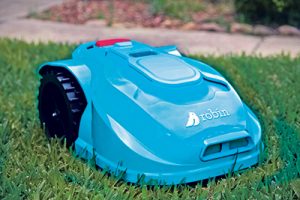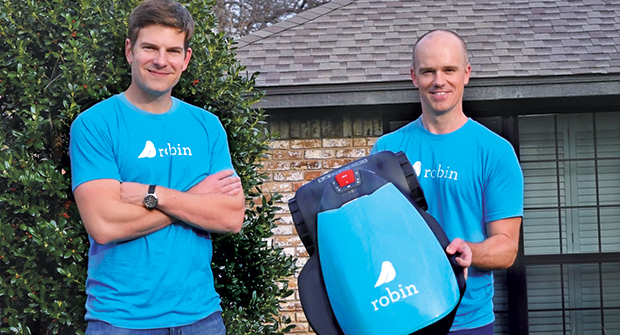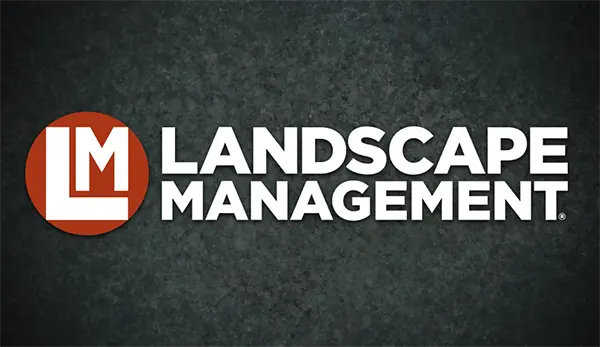
Dallas-based lawn maintenance company Robin looks to the future with robotic mowers.
While flipping through an issue of Wired, Justin Crandall came across an article about robotic lawn mowers. With a background in business startups and technology, he was intrigued by the concept and wanted in on the action.
“We look at ourselves as a tech-forward company and want to be the future of this industry,” says Crandall, co-founder and CEO of lawn maintenance company Robin, headquartered in Dallas, Texas. “If Uber is doing automatic cars and Amazon is doing drone delivery, we need to do robotic mowers.”
After doing his research, Crandall learned robotic lawn mowers have been popular in Europe for nearly 20 years, but they haven’t yet caught on in the U.S. In 2015, sales of robotic mowers in Western Europe were $360 million compared to $3 million in North America, according to a report by research firm Euromonitor International.
Robotic mowers are more popular overseas for several reasons, Crandall says: Gas prices are higher, and there are fewer landscape companies.
“Over there you don’t have this labor force that will roll up in front of your house and mow your lawn for $25,” he says, adding that robotic mowers cost anywhere from $1,500 to $4,500. “Most people in Europe aren’t replacing a landscape contractor, they are replacing themselves as the mower.”
Crandall and his partner, Bart Lomont, a U.S. Air Force veteran with a logistics background, founded Robin in 2015. The duo was inspired to start a lawn maintenance company after being frustrated by the bad experiences they’ve had when trying to find companies to service their own lawns. They launched Robin as an on-demand service in 2015 with a reported $1.2 million in seed funding.
Robin’s staff of 12 supports nearly 6,000 lawns in Dallas/Fort Worth, Austin, Houston, Atlanta, Miami and Tampa, Fla. With the tagline “Put Your Lawn on Autopilot,” the company’s goal now is to use robotic mowers to supplement the work of a traditional landscape crew.
“Our focus has always been on that wide-open, wild west of the fragmented residential maintenance market, as opposed to other companies that try to get out of that area as fast as they can and into other services like design/build and irrigation,” says Crandall. “We see this as the biggest opportunity to create good experiences for the customer.”
Last winter, Robin tested robotic mowers on 12 yards, including Crandall’s and Lomont’s. Crandall has so far tested seven different robotic mowers from five different manufacturers in his own yard. According to a story on DallasNews.com, he settled on custom units provided by Positech, Robomow and Husqvarna.
Since March, when the company formally introduced its robotic lawn care services to new and existing customers, Robin has installed more than 50 units. The model is install and lease. Customers pay an upfront cost of $99-$199, depending on yard size and whether they chose a month-to-month or annual contract, for the company to install the boundary wire within which the machine operates. Recurring pricing ranges from $15 per week for just mowing to $37 per week for full-service maintenance, which includes biweekly edging, weeding, trimming and fertilization.
“Customers are responding really well. People get out and take pictures of these things in action,” Crandall says. “But like any new service, we are having to learn things along the way and there have been challenges.”
Working out the kinks
One big challenge was theft. Of the 12 mowers installed at beta sites, three were stolen within two weeks. The company decided to install an aftermarket GPS tracker inside each unit. After reinstalling the remaining mowers, three of them were stolen again but were recovered thanks to the GPS capabilities. Right now, Husqvarna is the only manufacturer that includes a GPS tracker in one of its higher-end robotic mowers, Crandall says. His team is working to provide manufacturers feedback that GPS is a necessary addition to every model. All of Robin’s robotic mower service packages include insurance on the mowers and protection against theft.
Another concern has been the accidental cutting of the system’s wires by aerators and other machinery. The company also had to figure out how to deal with accessing fenced-in backyards without requiring the homeowner to purchase two units or having to physically move the mower from the front yard to the backyard. Crandall and his team invented a patented door technology that allows the robot to go through fences during mowing and remain locked when the mower is not in use to keep pets inside. The company spent the last six months creating and testing the prototype, and building the first 200 units.

The biggest downside is the systems are difficult to install.
“It takes five or six hours to install the first time, and you’ll want to beat it with a shovel,” Crandall says. “Now, with some experience, it takes us about three or four hours to install each unit.”
On the bright side
But there are plenty of positives, too, Crandall says. One of the major benefits is reliability and uptime.
Because the mowers are so quiet, they can run virtually any time, even at night, which helps keep Robin’s crews on schedule even during rainy or busy periods. While traditional crews are still needed for services such as edging, weeding, trimming and fertilization, Crandall says the robotic mowers allow their crews to dedicate more time to providing value-added services rather than sitting on a mower.
The mowers are also easy on the environment, using about 11 kilowatts of electricity—roughly the equivalent of a 60-watt light bulb—per month.
“With smog and pollution being such a big problem, this helps to reduce that,” Crandall says. “It may not be the reason a customer decides to get a robot mower, but it’s a reason they can feel good about it.”
For now, Crandall says Robin will continue to manage both its robotic and manual mowing services with a goal to be fully robotic in two to three years. He told DallasNews.com that the company’s goal is to install 50 mowers a month.
While he says he believes all homeowners who can afford to outsource their lawn maintenance will eventually go robotic, he adds that there are still many challenges for the industry to solve before that day comes.
“Eventually the combination of environmental friendliness, quiet operation, reliability and lower cost will win out,” Crandall says. “Successful landscapers already move up market away from basic mowing and toward higher margin services. We believe robots will just accelerate that natural evolution for the pros.”


